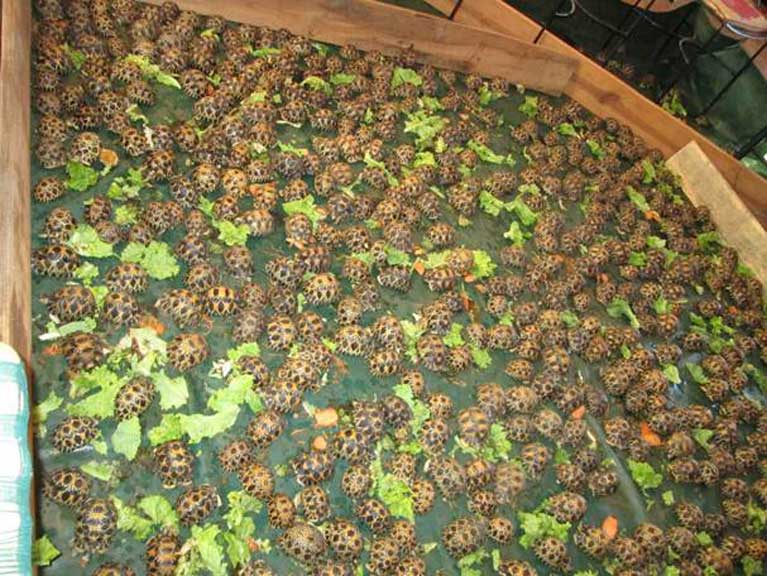- Numbering an estimated 12 million as recently as 2005, Madagascar’s Radiated Tortoise has experienced a drastic decline, and is currently listed as Critically Endangered on the IUCN Red List, with a projected extinction in the wild possible within 20 years.
- The continued survival of Astrochelys radiata, “the star tortoise radiating light,” is further imperiled by continued political unrest and economic upheaval in one of the world’s poorest nations.
- Local economic deprivation drives a brisk illegal trade in the species for food and pets, as global demand tempts betrayal of tribal traditions that once kept the animals safe from harm.
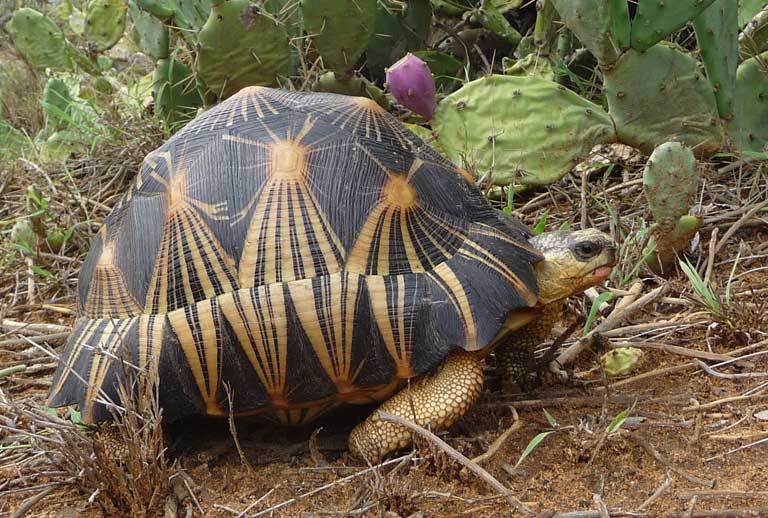
The Androy Region, Madagascar, October, 2011: Tandroy tribal elders in the village of Tragnovaho send runners to fetch government law enforcement officials to help apprehend poachers discovered in a nearby forest. A large group from the Antanosy tribe has walked over a hundred miles to hunt the formerly abundant Radiated Tortoise (Astrochelys radiata). The strikingly beautiful animals have disappeared from the margins of their former range once included in the Antanosy’s homeland, so the tribe is now forced to trek south into Tandroy territory to find them.
It’s not a march of starving desperation. “Tortoise meat has always been a delicacy,” explains Rick Hudson, President of the Turtle Survival Alliance (TSA), a conservation non-profit working to help the Malagasy learn about and conserve their native turtles and tortoises. “They cure the meat and sell it in towns to the north because people won’t eat chicken if they can have tortoise. They also collect the smaller juveniles for the pet trade. This deals a big blow to the local tortoise population; making it doubly hard to recover. It was always a local resource, but now poachers have additional markets, plenty of incentive, and little chance of getting caught.”
The markets Hudson is referring to are the rapacious black markets of a global, status-driven pet trade, as well as a huge demand for tortoise body parts in Chinese traditional medicine. A photo can be seen on social media of a Middle Eastern man with his stack of “pet” tortoises. Likewise, surveys of poaching sites have turned up hundred of shells, smashed in precisely the right way, proof positive that the tortoises had been killed for their livers — a body part considered an aphrodisiac in Asia. Formerly secure Radiated Tortoise enclaves are often targeted. At Cap Sainte Marie Special Reserve, one of the last places the tortoises are still found in significant numbers, “they come and take them right from under our noses,” Hudson reveals.


Though the economic incentives for illegal trafficking are exceedingly tempting, “only a minority of the Malagasy people poach,” explains Dr. Christina Castellano, a global chelonian expert working closely with the TSA in partnership with the Hogle Zoo in Utah, where she is an Assistant Director in charge of the zoo’s core conservation effort for the Radiated Tortoise.
“People in the south don’t have access to the information,” regarding trafficking, says Castellano. “The illiteracy rate is high, few can read, and there’s little on TV or in newspapers. They see the tortoises out and about in the forests and in their villages, but there was no real understanding that they were headed toward extinction.”
An ancient vow, a new attitude
As far as the Tandroy tribal elders in Tragnovaho were concerned, the Antanosy people were poaching, eating, and trading their relatives. Known to them as ‘Sokake’, the Radiated Tortoises are understood to be the returned spirits of village ancestors. More than that, the tortoises are seen as rainmakers — bringing the vital monsoons to their thirsty fields. There is a strict ‘fady’, or taboo, against eating or touching them. It’s this taboo which drives the Dina — a binding agreement among the animistic tribes of the Androy, the Mahafaly and the Antandroy, to protect Sokake.
The Dina is twofold. It considers any harm done to Sokake in areas the tribe protects as their responsibility. Evidence of poaching requires villagers to sacrifice a zebu, a species of cattle, in a cleansing ritual for the sin against sacred members of their extended family. With 9 out of every 10 Malagasy living on as little as two dollars a day, the need to purchase a zebu costing as much as US $500, is another strong motivation to uphold the Dina and keep the tortoises from harm.

Since June of 2012, villages in the Androy have been using enforcement of the Dina in a coordinated effort with TSA and the World Wide Fund for Nature (WWF), to protect the tortoises. “It’s really fortunate we have the Dina,” says Dr. Castellano. “I sincerely believe the reason that those animals are still there is because of the fady. If it wasn’t for the fady, I don’t think there would be any tortoises left.”
That October night in 2011 turned out to be the worst tortoise massacre on record, as 2,000 A. radiata carapaces lay bloody and empty. Malagasy forestry officials and national police vigorously assisted the villagers in enforcing the Dina — along with national and international laws — by apprehending six poachers and rescuing 200 Radiated Tortoises that were “tied to trees and ready to be slaughtered.” Later, the TSA helped fulfill the provisions of the Dina by supplying the necessary animals: a goat to the mayor for performing his duty, and a zebu for the cleansing ritual. It was a small victory, but an important one in an increasingly international effort to keep A. radiata wild.
A ruinous coup d’état
In 2008, the IUCN report that elevated the status of A. radiata from Vulnerable to Critically Endangered cited a “local use for food” as the major contributor to decline. Now, scientists cite the added factors of: dwindling habitat, loss of food sources, heightened poaching to supply the global pet trade, and extraction for Asian food and medicine markets, as severe threats to continued survival in the wild. The emergence of these dangers, and their accelerating impact, is closely tied to the political and economic upheaval that has plagued Madagascar over the last decade; and indeed, historically.
It’s easier to understand a Malagasy poacher’s motivations when one realizes that over 80% of the population lives in poverty, while there are Chinese consumers willing to pay up to US $50 for one tortoise. A juvenile A. radiata for the pet trade can bring thousands. Though this level of profit is not enjoyed at the lowest levels of the trafficking network, poachers still make money and risk little.

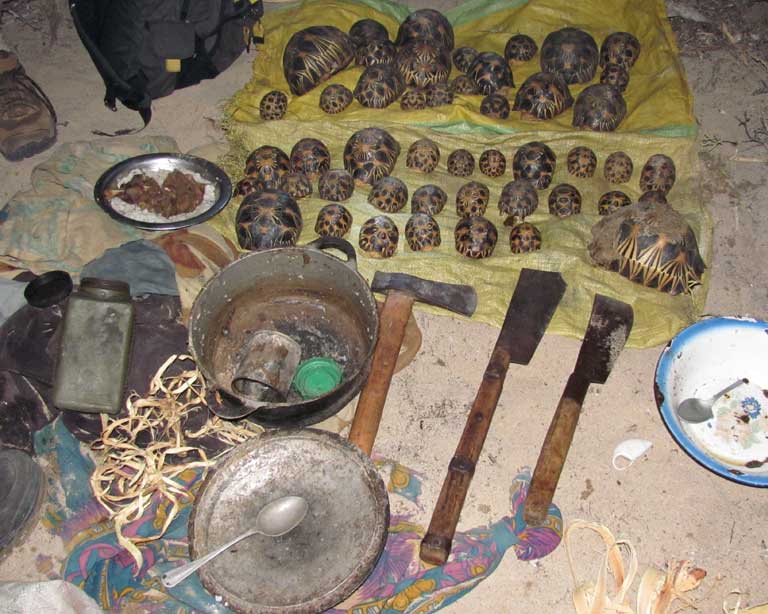
Madagascar’s political upheaval continues to hamstring the economy and drain any remaining environmental momentum the nation had prior to a political coup of 2009. Security and enforcement of anti-poaching laws were virtually non-existent under the so-called, High Transitional Authority that followed the takeover.
Hoping to jumpstart the economy and maintain power, the rogue government courted multinational corporations (MNCs), like mining giant, Rio Tinto. China, France and the US are major Malagasy trading partners, but it is the Chinese who are investing most heavily since the gates of commerce have been opened. It’s a shortsighted policy seen throughout the Developing World that maximizes extraction, industrial and agricultural development, while minimizing or refusing to acknowledge ecological damage. Example after global example has proven, states a report by researchers at the University of Michigan, that “when MNCs direct their globalization efforts to areas of relatively poor nations with rich land and rich biodiversity, a low environmental standard will inevitably lead to habitat destruction and species endangerment.”
It wasn’t always like this.
Loss of the Durban Vision
In September 2003, the Government of Madagascar announced sweeping environmental mandates that would essentially triple their nation’s “protected area network” from 1.7 million hectares to 6 million hectares (6.564 to 23,166 square miles) — approximately 10% of the country’s surface area — in the coming five years.
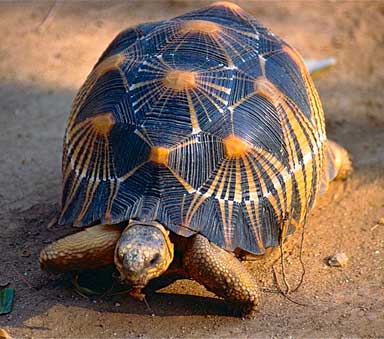
Known as the Durban Vision, it was a bold initiative to protect wildlife and ensure the growth of eco-tourism, the country’s second largest source of income, while earning the admiration of the global conservation community. Alarmed at perceived economic loss from the elimination of further mining and development on newly conserved land, the opposition party organized massive protests in Madagascar’s capital, Antananarivo, shut down the government, and eventually forced the coup.
The Durban Vision was all but forgotten. Foreign aid dried up as both regional and international government agencies refused to recognize and fund the coup-installed government.
Despite finally being allowed to elect a new president in 2012, the Malagasy people continue to confront severe environmental challenges brought on by the abandonment of the Durban Vision. In October 2010, the Malagasy Ministry of Planning and Decentralization awarded international investors a generous, long-term lease under the provisions of a 2003 law allowing Malagasy property to be sold or leased to outside investors without review. Tribal people who have traditionally occupied lands for thousands of years are finding themselves challenged to produce deeds, or lose their property. TANY, a Malagasy citizen’s action group formed to publicize and oppose the land grab, have pointed the finger of blame squarely at China and international corporations intent on securing prime agricultural land and raw materials for manufacture.
In the crosshairs at the crossroads
To fully understand the plight of the Radiated Tortoise, you need to step back into history. Madagascar is a largely undeveloped island nation roughly the size of France and situated about 250 miles off the east African coast in the Indian Ocean. Located along historic trade routes connecting Europe and Asia, its convenient placement, abundant food, diverse wildlife, and fresh water, attracted sporadic settlement and a hit and run brand of exploitation since the earliest human visitors floated over from Africa across the Mozambique Channel.

Later settlers came along the trade currents from Indonesia. At that time, there were two, larger tortoise species also inhabiting Madagascar; Dipsochelys grandidieri, a tortoise with a massive, atypically flat carapace, which became extinct about 1,200 years ago, and Dipsochelys abrupta, a more typical, high-domed tortoise that was partially sympatric, or able to share the same geographic range, with D. grandidieri. Scientists speculate they were both driven to extinction by human predation — along with most of Madagascar’s giant fauna, such as the Elephant Bird and Giant Lemur.
The first recorded accounts of Malagasy exploration belong to Arab traders who reached the island, searching for slaves, sometime in the 9th century. They showed no interest in settlement and it took until the 16th century, when a Portuguese ship captain landed on the island in 1500 to resupply with fresh meat and water, that Madagascar was formally charted on European maps. The meat they found was more than likely easily acquired: fresh Radiated Tortoise harvested by landing parties that pushed a few miles inland to the spiny forest lining the southern and southwest coasts.
Madagascar quickly became a wild, lawless land frequented by slavers and pirates. The island was a legendary pirate haven with many settling down permanently and intermarrying with the locals.
Well-armed natives drove off Portuguese and English attempts at settlement, and ruled the island in successive ‘monarchies’ until the French invaded in 1894. France maintained Madagascar as a colonial outpost and established trade in exotics like rosewood and vanilla until independence in 1963. The Madagascar Radiated Tortoise became a star during this unsettled period, appearing in natural history journals throughout the 18th and 19th century. Their brightly colored carapace patterns, so valued by natural history illustrators then, and pet collectors today, provide effective camouflage against predators in the tortoise’s arid, grassy habitat, allowing them to virtually disappear between the tussocks.
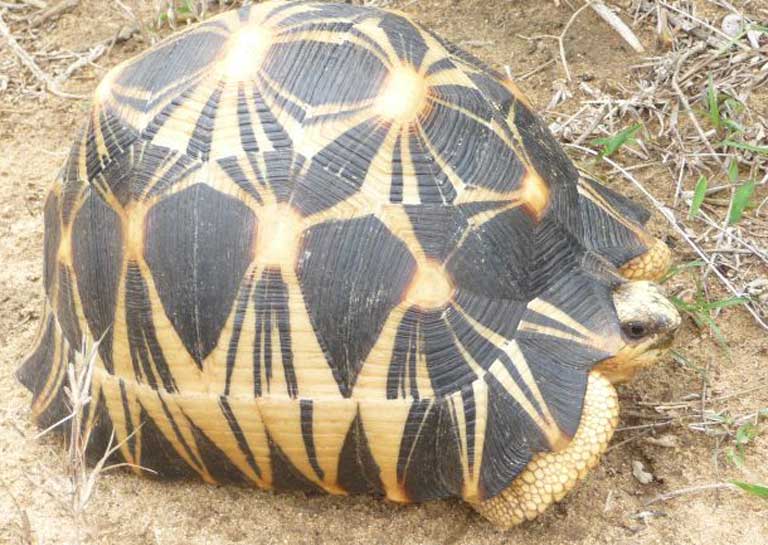
A. radiata quickly became a favorite specimen in museum and zoo collections, known for its beauty, calm disposition, ease in breeding, and longevity. One specimen, supposedly gifted to the King of Tonga by Captain Cook in 1773 (or 1777) reached the austere age of 189 years. Put into historic perspective, this tortoise was alive at the American Revolution and on into the Space Age. It passed away in 1966.
The ‘Radiated’ is a prolific species, with females laying up to twelve eggs annually. Before their current decline, immense populations existed in numbers that can only be imagined. TSA’s Rick Hudson was astounded at the density of individuals he found at Cap Sainte Marie in 1995. “They were so thick I had to be careful not to step on them; adults to just a few months old.” Natives advised him that the tortoises were often found on village footpaths and roads. Those roads are now empty; the current population estimated at less than six million — a decline of over 80% in the last 20 years and the reason the species ended up on the Red List.
An isolated evolution
Madagascar is a broad plateau ringed by coastal plains; wider in the west, and narrow in the east. A mountain range runs down much of the eastern side of the island, creating varying rainfall zones. Formerly covered by a wide variety of habitat — from temperate to tropical, grassland, jungle, and scrub — the plateau is now largely deforested.
With over 10,000 species found nowhere else on earth, and composing a staggering three quarters of Madagascar’s total biota, it’s no wonder Madagascar is considered a global hotspot for diversity. In a day when it seems scientific scrutiny has left no corner of the planet unexplored, Madagascar has continued to yield new discoveries. In 2015, several new species of ant and a possible new lemur species were found.
The unique biodiversity of Madagascar is due to geologic forces and a fortuitous location. Many animals and plants drifted, swam, or flew over from Africa, a few hundred miles away. Others were isolated when Madagascar, the former center of the super continent of Gondwana, finally separated from the Indian subcontinent about 80 million years ago. It was Madagascar’s unusual mammal population that first gave real credence to early tectonic plate theory as scientists noticed similarity between species in India and Africa to the lemurs of Madagascar.

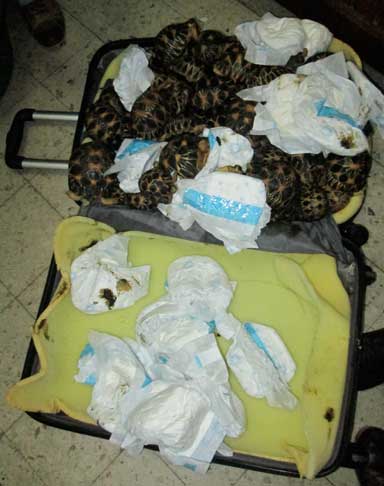
With star-patterned tortoises occurring in Asia and Africa, researchers assumed a common historical ancestor for Madagascar’s tortoises. After DNA analysis, it was found that the five endemic chelonians of Madagascar are more closely related to each other than to any continental species due to vicariance — geologic isolation, and then dispersal as the tortoises spread throughout Madagascar’s varied habitats and became separate species in their own right and in their own niches.
The Malagasy tortoises also exhibit some sympatry. This is not common among tortoise species, but can happen when generalist feeders occupy the same range as specialists. Size differences, and perhaps shell patterns, can prevent hybridization. The medium-sized Radiated Tortoise likely shared their range with the now extinct giant tortoises; whose extraordinary fossils can still be found in the spiny desert. The disappearance of these large tortoises, along with the extinction of possible predators like the Elephant Bird, may account for A. radiata’s amazing density of up to 2,200 individuals per square kilometer recorded in 1995. Today, the larger, 16-inch tall, 35 pound (40.6 centimeter and 15.8 kilogram) A. radiata is sympatric with the pocket-sized Critically Endangered Spider Tortoise, Pyxis arachnoides; sharing both common ground and an uncertain future.
Tortoises outside Madagascar’s reserves now spend their days avoiding the crushing hooves of cattle along the margins of charcoal burns and agricultural fields. Some are kept by villagers, not bound by the fady, in enclosures with chickens — the tortoises eat chicken feces and keep disease down.
The spiny forest is still there, but now fragmented and dominated by the Prickly Pear (spp. Opuntia) — an introduced species that spreads with the help of cattle, and ironically, the Radiated Tortoises. An active daytime forager, the tortoises’ herbivore diet previously consisted primarily of plants from the Didieraceae and Euphorbiaceae families along with native fruits and grasses. Now forced to increasingly rely on Opuntia, the chelonians are often found “mouths stained with the red juice and hiding between the plants” according to Hudson.
“Though Opuntia offers much needed cover for the tortoises as the native grasses disappear from overgrazing, drought, and burning for charcoal, no one knows what the long-term effects may be if [the tortoises] have to rely on Prickly Pear more and more for food,” cautions Hudson. “It’s another piece in a complex puzzle.… We’re currently funding a Malagasy graduate student who is studying the situation.”
All of Madagascar’s five endemic tortoises and turtles are currently listed on the IUCN Red List as Critically Endangered.
Global triage offers hope to tortoises and people
The 200 survivors of that October 2011 massacre were quickly turned over by law enforcement and villagers to the TSA team, which has established four triage centers in southern Madagascar to deal with chelonian confiscations in response to Madagascar’s poaching and trafficking crisis.

Those triage centers have been hard at work moving tortoises seized by officials safely back into the wild. Despite the horrible sight of hundreds of juvenile A. radiata confiscated on roadways, at airports and seaports, diapered and stuffed into suitcases, taped inside their shells to stop them from moving and making noise, the triage teams of locally trained workers and scientists are positive and upbeat.
“We work there because we’re hopeful,” Dr. Castellano explains. “The Malagasy people, especially in the south, want this animal around. It’s part of who they are, it’s part of their tradition, and part of the environment. We’ve found a tremendous amount of support, and that’s one of the key pillars of our conservation program.” That program focuses on four things, she says: building law enforcement capacity to stop poaching and protect wild populations; a reintroduction program to get confiscated tortoises back into the wild; applied science that supports graduate-level research that informs the reintroduction program; and finally, conservation education.
“We started doing public awareness first to give everyone the background on what’s happening,” says Dr. Castellano. “When we got down to southern Madagascar, people didn’t understand the situation, so we find ways that we can connect with people on a level that helps us form those relationships and share our conservation messaging.”
In 2008, the IUCN led the process to re-evaluate the status of A. radiata that resulted in a series of three workshops bringing leading chelonian experts to Madagascar to strategize solutions to the crisis. Shortly after, the Hogle Zoo in Utah and the TSA partnered to begin building relationships in the communities that bordered Radiated Tortoise habitat. One of their first endeavors was to make A. radiata a film star by shooting a short movie, Tortoises in Trouble, in partnership with The Orianne Society, Madagascar National Parks, and MOZ Images (a South African film company) to publicize the key role communities would need to play in ensuring the Radiated’s survival.
Laying the social groundwork has been essential to restoring Radiated Tortoise populations. “We completely recognize that the key to the success of the reintroduction program is building relationships with those communities that allow us to work in their villages and on their lands. We recognize that without their support, we couldn’t be there. It’s very much a grassroots program in the villages,” says Dr. Castellano.
“We have meetings in the capital of Tana [Antananrivo] and address the political side, but where change is going to happen is in those communities,” she adds. “It’s those people who are affected every day by what’s happening with the environment and those animals. For us it’s about giving them tools, resources, and support for making that change happen.”
And so they have, creating four triage centers to handle the overflow of tortoise confiscations from the confiscation center in Ifaty run by the Village des Tortues in France, supplying motorcycles to the Gendarmes (police) for security and aid in catching poachers, helping meet the obligation of the Dina in poor communities, building a new school in the village of Antsakoamasy within the heart of the Radiated Tortoise’s territory, supporting graduate-level research projects by three doctoral students (two of whom are Malagasy), holding husbandry workshops to train local people to assist in reintroduction efforts as confiscations increase, and, most importantly, laying the groundwork for a regional, multi-purpose Tortoise Conservation Center (TCC).
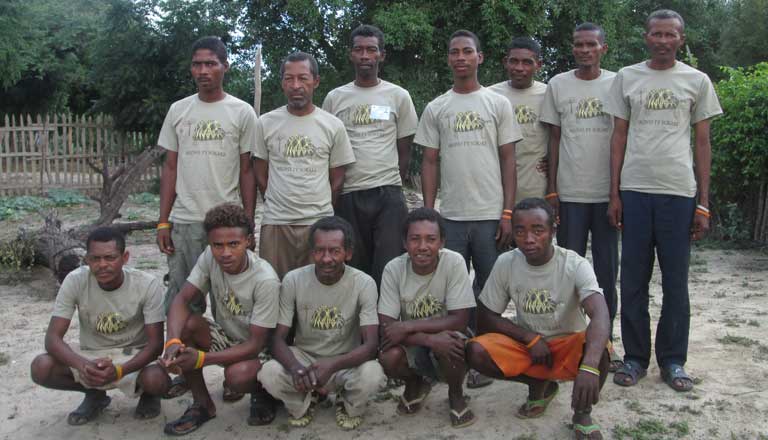
The TCC is “ the next big step and the lynchpin for our efforts on behalf of the Radiated Tortoise,” explains Hudson. “The TCC will provide veterinary and supportive care for southern Madagascar’s tortoises, and include a training center for workshops, and provide living quarters for graduate students and visiting scientists.”
It’s not all hard work and no play. The international outreach efforts also included a successful 2015 community event called ‘Soccer for Sokake.’ The conservation NGOs arranged a soccer tournament and parade, with team names and identities based on local wildlife; involving the youngest to the oldest members of the village in Lavanono. Participants proudly posed in new t-shirts with bold images of A. radiata.
These efforts are paying off. Confiscations of trafficked tortoises have steadily increased and local awareness has grown. The TCC and the four triage centers located along key trafficking routes aim to use IUCN scientific standards to implement reintroduction. Conservationists and local communities are rising to meet the challenge.
“As much as we’ve been doing education outreach, we’re still scientists,” muses Dr. Castellano, adding that, “When you work in a culture or environment that has been exploited in the past, building trust is difficult and it takes a long time. It’s pretty much a lifetime commitment. We value our relationship with the community and the village leaders, who can really make a difference with this animal,” she says. “It’s never going to be us. It’s always going to be them. It’s getting people there… to the place where they can do it. It’s about protecting a species, protecting the environment, and ultimately, it’s about protecting their way of life.
“It’s really a holistic idea,” Dr. Castellano concludes. “The TCC is about the animals, the forest, the people, and our commitment; we aren’t going anywhere and we’re hopeful for the future. I really do think this story could have a happy ending.”

Citations:
Peter C. H. Pritchard, (2008) Madagascar: Island Continent of Tortoises Great and Small. ppg. 17-20; Published in: Castellano, C.M., Rhodin, A.G.J., Ogle, M., Mittermeier, R.A., Randriamahazo, H., Hudson, R., and Lewis, R.E. (Eds.). Turtles on the Brink in Madagascar: Proceedings of Two Workshops on the Status, Conservation, and Biology of Malagasy Tortoises and Freshwater Turtles. Chelonian Research Monographs 6:171–177.
A. Mittermeier, P. P. Van Dijki, A. G. J. Rhodin, S. D. Nash (2008) The Tortoises and Freshwater Turtles of Madagascar in the Context of Biodiversity Conservation in the Madagascar Hotspot. ppg 25-31; Published in: Castellano, C.M., Rhodin, A.G.J., Ogle, M., Mittermeier, R.A., Randriamahazo, H., Hudson, R., and Lewis, R.E. (Eds.). Turtles on the Brink in Madagascar: Proceedings of Two Workshops on the Status, Conservation, and Biology of Malagasy Tortoises and Freshwater Turtles. Chelonian Research Monographs 6:171–177.
Randriamahazo, R. Hudson, C. Castellano (2012) TSA Madagascar Leads Fight to Conserve Imperiled Radiated Tortoise. Turtle Survival 2012, pp. 24-27
Randriamahazo, R. Hudson, C. Castellano (2013) Rise in Tortoise Confiscations Underscores Need for New TSA Triage Centers. Turtle Survival Journal 2013, pp. 28-30
Randriamahazo, A. Currylow, R. Hudson, C. Castellano (2014) Mobilizing TSA’s Confiscation to Reintroduction Strategy for Radiated Tortoises. Turtle Survival Journal 2014, pp. 34-37


